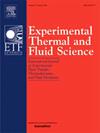过跳跃式边界层湍流远场阶段的尾迹行为和夹带运动
IF 3.3
2区 工程技术
Q2 ENGINEERING, MECHANICAL
Experimental Thermal and Fluid Science
Pub Date : 2025-09-13
DOI:10.1016/j.expthermflusci.2025.111617
引用次数: 0
摘要
本文研究了不同壁挂绊网堵塞率σw对过绊网边界层(OT-BL)湍流的远场尾迹行为和夹带运动。摩擦雷诺数Reτ是无扰动正则湍流边界层的两倍以上。OT-BL的远场流向发展是壁面驱动和尾迹驱动机制的协同作用。利用空间两点相关和间歇因子对壁面驱动和尾迹驱动范围进行量化。壁面驱动对绊网配置的依赖性较弱,而尾流驱动则明显与绊网配置相关。尾迹驱动区随下游发展呈上升扩展趋势,与绊索σw呈正相关。从湍流/非湍流界面的角度揭示了湍流区和近界面区的尾迹动力学。在上游阶段,尾迹由绊索激发的扰动涡流控制,而在下游阶段,近界面尾迹动力学逐渐向规范模式靠拢。此外,夹带被认为是基于啃咬和吞噬的运动。对于OT-BL,绊索激发扰动涡流增强了啃咬和吞噬夹带。咬食夹带是主要的夹带方式,吞没过程也是一个重要的组成部分。最后,研究评估了OT-BLs尾流动力学和夹带运动的远场恢复趋势。该研究为在有限试验段模拟高reτ OT-BL的绊网设计提供了参考。同时,从多个角度探讨了OT-BL尾流湍流特性的评价方案。本文章由计算机程序翻译,如有差异,请以英文原文为准。
Wake behavior and entrainment motion in the far-field stage of over-tripped boundary layer turbulence
This study investigates the far-field wake behavior and entrainment motions of the over-tripped boundary layer (OT-BL) turbulence induced by a family of wall-mounted tripwires with different wall blockage rate . Friction Reynolds number is more than twice that of the unperturbed canonical turbulent boundary layer. Far-field streamwise development of the OT-BL is referred to as a cooperative action of wall-driven and wake-driven mechanisms. Spatial two-point correlation and intermittency factor are employed to quantify the wall-driven and wake-driven ranges. The wall driver shows a weak dependence on the tripwire configuration, whereas the wake driver is clearly related to the tripwire configuration. Along with downstream development, the wake-driven region exhibits an upward and spreading trend, which correlates positively with of tripwires. The wake dynamics in turbulent region and near-interface region are revealed from the turbulent/non-turbulent interface perspective. In the upstream stage, the wake is controlled by the tripwire-excited disturbed eddies, and then, in the downstream stage, the near-interface wake dynamics are gradually similar to canonical pattern. Further, entrainment is considered based on nibbling and engulfing motions. For OT-BL, tripwire-excited disturbed eddies enhance nibbling and engulfing entrainment. Nibbling entrainment is the main entrainment mode, although engulfing process is also a significant component. Finally, the study assesses the far-field recovery trend of the OT-BLs’ wake dynamics and entrainment motion. This research provides a reference for tripwire design to simulate higher- OT-BL in a finite test section. Meanwhile, we discuss the evaluation scheme on the wake turbulence characteristics of OT-BL from multiple perspectives.
求助全文
通过发布文献求助,成功后即可免费获取论文全文。
去求助
来源期刊

Experimental Thermal and Fluid Science
工程技术-工程:机械
CiteScore
6.70
自引率
3.10%
发文量
159
审稿时长
34 days
期刊介绍:
Experimental Thermal and Fluid Science provides a forum for research emphasizing experimental work that enhances fundamental understanding of heat transfer, thermodynamics, and fluid mechanics. In addition to the principal areas of research, the journal covers research results in related fields, including combined heat and mass transfer, flows with phase transition, micro- and nano-scale systems, multiphase flow, combustion, radiative transfer, porous media, cryogenics, turbulence, and novel experimental techniques.
 求助内容:
求助内容: 应助结果提醒方式:
应助结果提醒方式:


